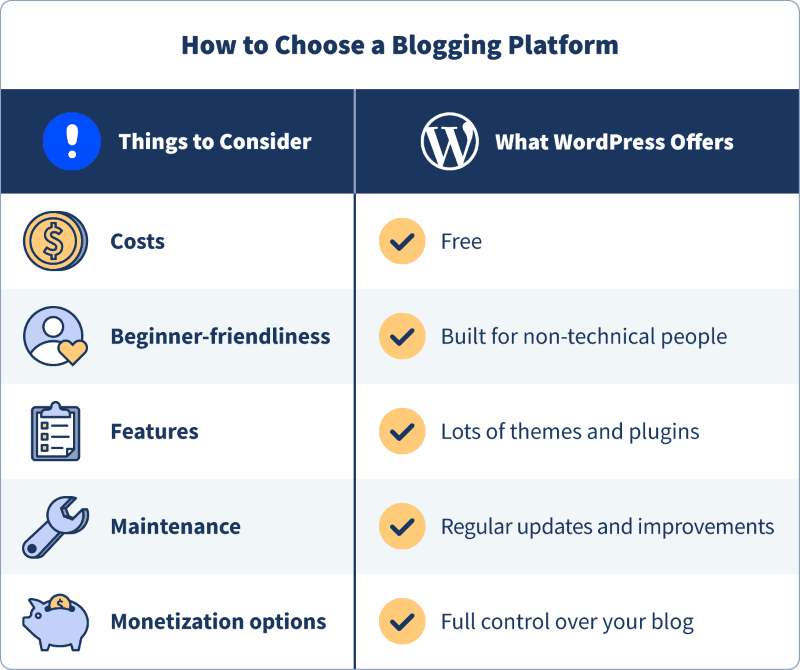Starting a blog in 2025 is one of the best ways to share your passion, build an audience, and even create a profitable online business. But where do you start in creating a successful blog?
In this step-by-step guide, you’ll learn how to start a blog from scratch, set it up the right way, attract readers, and explore multiple ways to make money blogging. Whether you’re blogging as a hobby or aiming to build a business, these proven steps will set you up for success.
By the end of this guide, you’ll know how to:
- Choose a blog niche that attracts readers
- Set up your blog on WordPress
- Write high-quality, SEO-optimized blog post
- Get traffic to your blog & grow an audience
- Monetize your blog for passive income
Step 1: Pick a Niche for Your Blog
While some may consider themselves jacks of all trades, the final portion of that particular idiom is never truer than when discussing blogs: jack of all trades, but master of none. In trying to do too much on your blog, you are unlikely to effectively market to your audience, rank well in search, and maintain the interest of your readers. A successful blog is one that develops blog content within its niche, so select a dedicated niche to come up against fewer competitors, demonstrate greater authority, and see easier monetization.
How to Find a Profitable Niche

To pick the niche that best fits your blog content, identify an area that meets demand, allows you to indulge in your passion, and offers some monetization potential. Identifying a niche that meets all three of these requirements can be difficult, but it is vital.
Without passion, demand and money will likely drag, and the lack of passion will come through in your blog content. With passion and demand, but little to no monetization potential, you have found a hobby. In combining the three, you can create a blog from scratch that can meet the desire to both pursue your passions and provide an income stream.
Validate Demand
Google trends and keyword research tools can be a great way to perform well in Google Analytics, and can also help you determine where you are best putting your attention and energy to create a blog from scratch.
To use Google Trends, navigate to Google Trends and type in the keyword in which you are interested. Using a keyword or a phrase, you can use Google Trends to identify what people are saying on the topic, how popular the topic is, and even where the topic is being discussed most. From there, you can determine how popular your keyword is and further inform your desire to find your niche.
Keyword tools can be used to accomplish the same basic feat, from different sources. By entering a keyword and looking at related topics and interests, you can further refine our search for a niche.
Examples of Profitable Blog Niches in 2025:
Crafting a blog from scratch is challenging, but there are several niches that remain dynamic and thriving for those hoping to choose a blog platform and hit the ground running. Some examples of profitable niches in 2025 include:
- Personal Finance
- Health & Wellness
- Tech & AI Trends
- Remote Work & Freelancing
- Food & Travel
If you find yourself interested in any of these broader topics and you have a subset of interest or expertise within any of these categories, you may be one step ahead of the game in your blogging journey.
Further Reading: 13 Most Profitable Blog Niche Ideas For 2025
Step 2: Choose the Right Blogging Platform (Why WordPress is Best)

No matter your blog theme or the type of professional or personal blog you are working to develop, your blog platform is an essential piece of the puzzle. There are many blog platforms out there, but a self-hosted WordPress blog is among the best possible options.
WordPress has long been the preferred platform for personal blogs and professional blogs alike, in large part because the site successfully hosts all types of blogs with a wide range of valuable tools available for bloggers. Many site builders are most familiar with WordPress as a platform, and it is an intuitive platform that allows even a novice to create the type of blogs they are most interested in developing.
Self-hosted WordPress.org vs. Free Blogging Platforms (Medium, Blogger, Wix, etc.)
A self-hosted WordPress blog is ideal, because it does not present with the same common concerns free blog platforms like Medium, Blogger, Wix, and others present. These platforms may be free, but they do not offer the same substantial suite of tools, they do not index as effectively in search, and they do not offer the same fluid usage that paid platforms offer.
Although these options may be great for the type of blogs used to simply delineate opinions or post general thoughts, a self-hosted WordPress blog is better for professional blogs in need of a blog theme and function to support professional aspirations. These blogs are better suited for affiliate links, high-ranking SEO, and even functionalities like email newsletters and sourcing relevant images. With plenty of plugins and other sites designed to work with WordPress, WordPress sites are among the best to work with, no matter your industry.
Benefits of WordPress.org
WordPress is ideal for your blogging journey in three very important ways. These include:
- Full customization & control: WordPress offers the ability to customize your site completely. It has also given its users the opportunity to control their site in virtually all aspects, offering greater customization and personalization.
- Best for SEO & monetization: SEO and monetization are best on WordPress.org, because the platform has built-in Search Engine Optimization tools and scores, to help improve your search scores. They also provide ways to monetize your blog more effectively through ads.
- Thousands of themes & plugins: Design elements are vital when creating your blog, and WordPress offers a seemingly limitless number of themes from which to choose. Plugins are also abundant, ranging from keyword tools to affiliate marketing plugins, to plugins to link your socials to your site.
Essential WordPress Plugins Shortlist
From email lists to top-performing SEO, there are many valuable plugins that are essential for the smooth, effective running of your WordPress site. Some of the top plugins I recommend include the following:
- SEO Plugin: Yoast SEO or Rank Math. Both of these plugins will help you develop pages and blog posts that perform well in SEO metrics.
- Security Plugin: Wordfence or Sucuri. Each of these plugins helps keep your site secure from malware attacks and hacking.
- Speed Optimization: WP Rocket or LiteSpeed Cache. Speed optimization can improve your audience’s blogging journey, and can help your SEO performance.
Step 3: Get a Custom Domain Name & Web Hosting

While free sites can certainly be tempting, they do not deliver the same sense of authority that a custom domain does. To capture your ideal readers and keep them coming back for more, consider selecting a custom domain name and dedicated web hosting. Doing so is often the first step in creating a beautiful blog that you can tailor to fit your needs and design preferences.
How to Choose a Blog Name
In the age of AI, you can use ChatGPT to help find a blog name. Name generators can be particularly useful if you do not already have a steady stream of content coming from elsewhere, like a social media platform. On the flip side, if you already have socials you post to on a regular basis, and a steady stream of content, opt for a name that either directly matches your socials, or is in some way related to your socials.
Trying to Keep Up with Digital Marketing?
Just released: my new book to help small businesses, entrepreneurs, and marketers master digital marketing in today’s digital-first world.
Drawing on my Fractional CMO experience, Digital Threads simplifies complex strategies into clear, actionable steps for success.
Transform your business today—grab your copy! Click the cover or button below to buy on Amazon.
Best Domain Extensions
Domain extensions may have once been largely either “.com” or “.org,” but as the internet has expanded, more options have become available–and, in some cases, have become necessary. As you begin creating your blog, try to opt for a “.com” domain extension. If that is not available, “.blog,” “.net,” and “.co” are all acceptable alternatives.
Recommended Web Hosting Providers
Finding a web host for your WordPress site does not mean investing in the highest-end host, or buying into every piece of digital marketing out there, urging you not to skimp on your host. Some of the web hosts I recommend that are both popular and on the lower end include Bluehost, SiteGround, and Hostinger. All of these are great options for many different types of content, without breaking the bank.
Step-by-Step Guide to Get Started
To get started step-by-step, you must first select your preferred web host provider. Most hosting sites offer a simple one-click installation to utilize WordPress as your site designer. This means that you must…
- Select Your Host
- Choose Your Site Name
- Register Your Domain Name
- Install WordPress.
While it may seem difficult to create a well-designed blog, the process is often quite simple, and there is plenty of help available in the blogging community, with each hosting site typically offering a step-by-step break down of the necessary tasks.
Step 4: Set Up Your Blog

After you have completed the previous step, you can move on to actually deciding on your preferred blog theme, the design you’d like to implement, and the most essential settings of your site. These steps will be completed immediately after you install WordPress on your chosen web host server.
There are several free WordPress themes that offer a great starting point for beginners, including Kadence, Astra, and GeneratePress. Using these themes, you can easily customize using basic blogging tools, and design a frill-free site to get your point across.
Although there are plenty of in-depth steps to create a complicated design for your blog, there are also plenty of tools that can help you customize the design of your blog without knowing how to code. Block editors and page builders like Elementor and Gutenberg are used by novices and prominent bloggers both to customize their sites.
Before you get to blogger posts, there are a few steps to take to make sure any reader reading your blog can get meaningful questions answered, and can understand who you are and what sets you apart. Must-have blog pages include:
- About: This page should briefly detail who you are, what your blog is about, and why you have created it. Keep clean design in mind, and try to include personal touches like photos and internal links.
- Contact: Your contact page is one of the most important parts of your entire design; while it is not a flashy page, it lets your audience know how to get a hold of you to pursue unanswered questions, request more information, or simply connect.
- Privacy Policy: Your privacy policy page will detail domain privacy practices. This means that your readers will be informed of how data is collected and stored, and how it is ultimately used by you or your brand. Free generators and templates can help you develop a tailored privacy policy.
- Disclaimer: Disclaimer pages are essential for prominent bloggers and newcomers both, as it details any marketing found on your posts or within your site. The community of people reading your blog posts should be informed regarding any affiliate marketing, ads, or sales you may produce on your website.
Further Reading: 13 Best AI Website Builders to Create Stunning Sites Fast
Step 5: Write & Publish Your First Blog Post

Now for the exciting part: creating content people can read and come back to again and again! Every piece of content needs a basic framework from which to work, so before you write and publish your first blog post, make sure you have a series of blog post ideas at the ready. Whether you host a recipe blog or a travel blog, delivering a steady stream of content on a regular basis will vastly improve your likelihood of success.
How to Find Great Blog Topics
The research you completed regarding your niche will come in handy here, as you will have already conducted some keyword research and developed a basic understanding of your target audience’s needs. From there, you can develop blog post ideas that utilize your preferred keywords and topics.
As you continue writing and producing a steady stream of content, you can begin to utilize tools like Google Analytics to evaluate your blog content and visitors, to continually refine your topics and meet the needs and preferences of your audience. Google Analytics metrics can demonstrate which blog posts are bringing in visitors, to make sure you are focusing your blog posts on those topics.
Further Reading: 67 Best Blog Post Ideas to Get More Traffic and Leads
Blog Post Structure Best Practices for Readability & SEO
It can be tempting to create your blog and hit the ground running. Maintaining the attention of your ideal readers requires some finesse, however, so it is important to follow a basic outline for your blog posts. This outline looks something like the following:
- Headline: Use power words & keywords. Your headline is what draws attention and tells your ideal readers the type of blogs you are creating. Use your headline to answer common questions and grab attention.
- Intro: Hook the reader & set expectations. Your intro should describe the blog content you are creating, while letting your ideal readers know why they should stick around.
- Body: Use H2, H3 headings, bullet points, and short paragraphs. These help satisfy Search Engine Optimization requirements, but also help direct your audience. Successful bloggers use these elements to keep the body of their blogs neat and easy to read.
- CTA: Encourage comments, shares, or sign-ups. Email subscribers are often vital for the success of a blog, so make sure you include CTAs (calls to action) for your blog traffic. You can use a CTA to direct to an affiliate partner, to gather an email address, or even direct to online courses or other subject matter you have covered.
SEO Tips
SEO is vital to bring in traffic from search engines, so I cover it in great detail on my blog. To make sure that your blog layouts and content are bringing in your audience, focus on the following:
- Meta Titles and Descriptions: Meta titles and descriptions help identify your blog content. Create meta titles and descriptions for each individual blog for search engine optimization improvements.
- Alt Text for Images: Like meta titles and descriptions, alt text helps identify what your private or stock images are all about, and how they relate to your topic.
- Internal Linking: Internal links help establish your site as a valuable one, and your blogs as reliable. By linking internally, you encourage your daily and monthly readers to check out other blog posts and each piece of content should include at least one, if not multiple internal links.
Step 6: Promote Your Blog & Get Traffic
Whether you use a BlueHost portal to publish your WordPress blog, or you utilize in-house hosting, you will be responsible for promoting your blog and making sure your blog posts are seen. Fortunately, there are plenty of ways to market your blog posts, and make sure you are bringing in organic traffic to the type of blogs you create.
Further Reading: 25 Effective Ways How to Promote Your Blog in 2025
SEO (Search Engine Optimization)
Search engine results are invaluable. Optimizing your blog posts to improve Google ranking and support generative AI search traffic will go a long way in bringing in your ideal readers. Tools like Yoast SEO can help in this endeavor, as can conducting thorough keyword research before you generate blog post ideas.
Social Media Marketing
Publishing content on a regular basis is far more important than having a premium theme or even creating a beautiful blog. One of the best ways to indicate that you are posting on a regular basis is to take to your social media platform of choice. On platforms like Facebook, Twitter, Pinterest, and LinkedIn, you can effectively build a community and get your blog noticed both by your ideal readers and by affiliate partners with whom you’d like to work.
Email Marketing
Describe how to use lead magnets to build a list with ConvertKit or Mailchimp to keep in better touch with your visitors and ultimately generate more blog traffic through introducing new blog posts to them.
Guest Blogging & Backlinks
Guest posting as acting as a guest poster are great ways to get noticed. By getting featured on larger websites via a guest post, you can generate digital PR and backlinks–both of which benefit your SEO efforts.
Quora & Reddit
Successful bloggers take to sites like Quora and Reddit to answer common questions related to the types of content they create. By addressing unanswered questions about your blog topics, you can establish yourself as an authority and include a link for reference to help build traffic.
Step 7: 5 Best Ways to Monetize Your Blog & Start Making Money
Now that you understand the basics of blogging–how to set up your blog, how to use image sites, how to navigate to your login screen and post editor screen, and how to choose a host–you can move on to evaluating the best monetization strategy for your own blog. I have identified the 5 best ways I have found to develop content people need and monetize your work. Consider the following:
1. Affiliate Marketing
Affiliate programs like Amazon Associates and Bluehost can provide a great way to generate income. These programs allow you to simply post links to products you use, in order to receive a cut of the final price. Each program offers its own step by step guide for successful implementation.
2. Google AdSense & Display Ads
Monetizing your blog traffic is a breeze through Google AdSense and Display Ads. These ads can be placed on the type of blogs found in virtually any niche. Some are simple bars across the bottom of the screen, while others are larger. All provide passive income, however, as they are essentially paying to take up space on your site or page.
3. Sponsored Blog Posts
Sponsored blog posts are a great option, and they can be created on a regular basis as you partner with brands. These posts can place a hefty emphasis on the product or brand, or can include a product or mention in passing. Many sponsors offer blog post ideas of their own, to make sure content creators comply with all brand requirements.
4. Sell Digital Products
eBooks, online courses, templates, and memberships are all great ways to bring income in from your blog. Email lists and email newsletters can both be used as vehicles through which to market these products, but your blog posts can also advertise your offerings on a regular basis through targeted calls to action and even a “common questions” tab on your site.
5. Freelancing & Consulting
When you post on a regular basis and utilize tools like Yoast SEO to craft high-ranking posts, you can actually use your blog as a portfolio to demonstrate your expertise and advertise your freelancing and consulting services. Successful bloggers can often point to traffic from search engines as proof of their success amongst the blog public, and leverage that to coach or consult for other bloggers or professionals in their niche. Note, though, that intermittent blogging may not lend itself to this particular form of monetization, and more consistent posting is key.
Further Reading: How to Monetize a Blog in 2025 (4 Proven Ways)
Get Started Blogging TODAY!
Blogging is one of the best ways to build a brand, share your knowledge, and create a long-term online business.
Now it’s your turn! Follow these steps to start your blog today and begin your journey toward financial freedom.
Ready to launch your blog? Click here to get your domain + hosting at a discount! (Insert affiliate link if applicable)
Have questions? Contact me and I’ll be happy to help!










